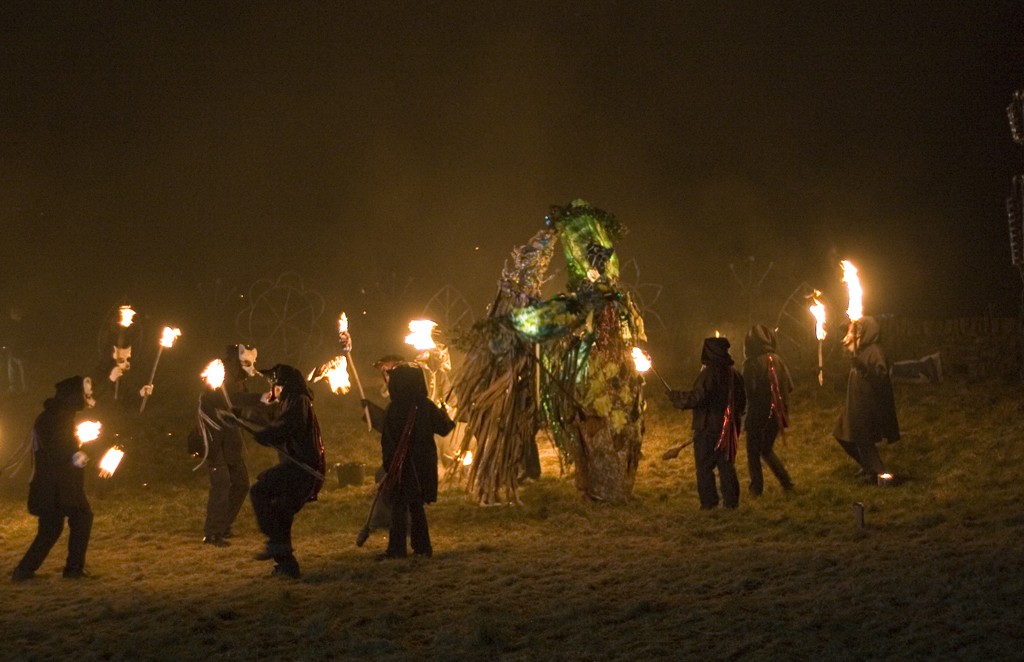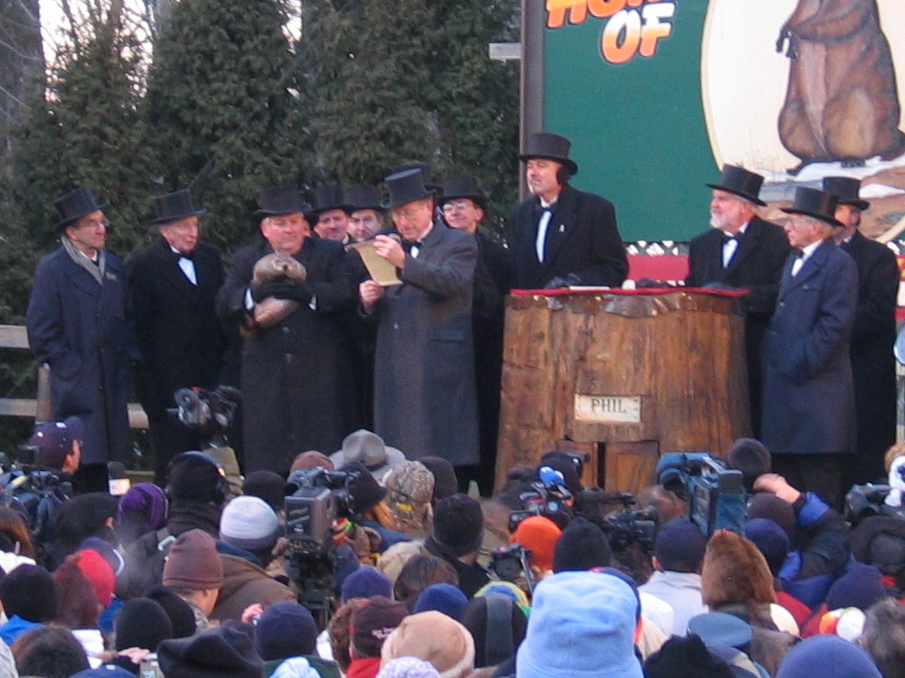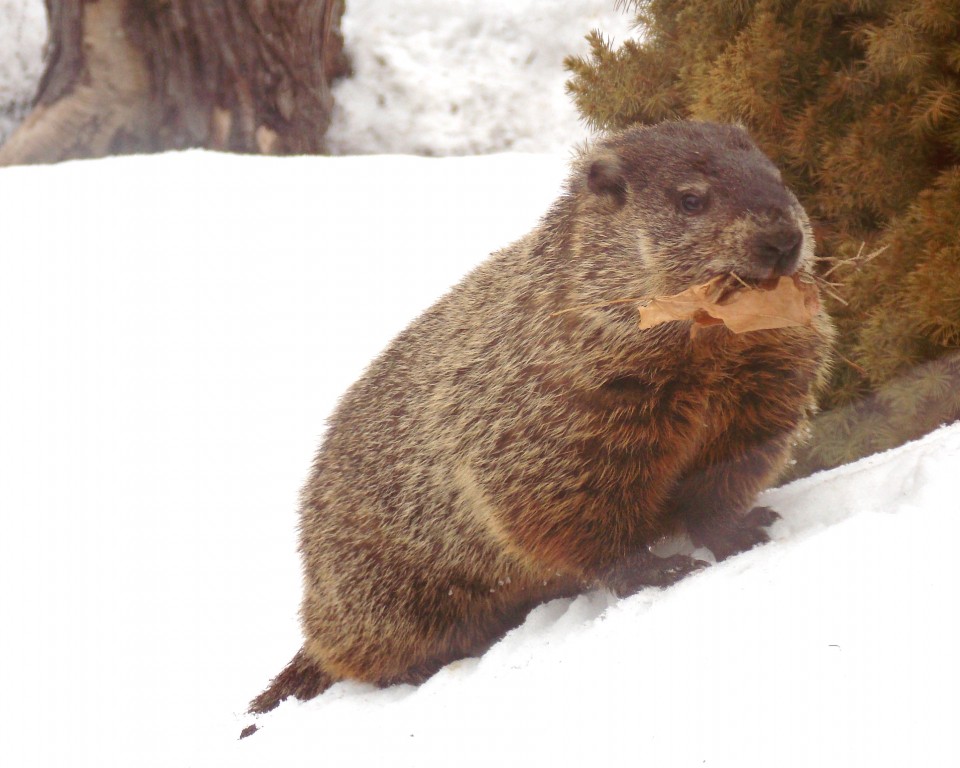“Whistle Pigs,” Punxsutawney and the backstory of Groundhog Day
I enjoyed the 1993 film “Groundhog Day” starring Bill Murray, and watched it several times. Or at least that is how it seemed. Like the movie, Groundhog Day 2017 is unlikely to be noticeably different than previous iterations. Really, it’s a perfect holiday for early February as we struggle to resist our ancient urge to hibernate. At this time of year, each morning holds the same ritual: we stumble out semi-conscious in the morning to defrost the car, shivering under an unchanging gray sky, wondering what day of the week it is. We probably couldn’t handle an exciting holiday this early in the year.

Fire-bearers circle figures of The Green Man fighting Jack Frost. Imbolc celebration in Marsden, West Yorkshire. Photo: Steven Earnshaw, Creative Commons, some rights reserved
The notion that sunshine on the second of February indicates a late spring began in ancient Europe. That date marks the pagan festival of Imbolc, halfway between the winter solstice and spring equinox. In the Celtic world, Imbolc was (and for some, still is) a celebration of the goddess Brigid (Brigit), traditional patroness of healing, poetry, hearth and home, agriculture and fertility. She was also a fierce warrior who slayed adversaries like a champ. As Christianity spread, Imbolc was supplanted by Candelmas Day, dedicated to (surprise) St. Brigid, who presumably refrained from killing people. But both traditions reference the “sunny equals more winter, and cloudy means spring” theme.
Mostly because Europe lacked groundhogs, Groundhog Day was invented in the New World, first popping up among Pennsylvania Germans (who were steeped in the Candelmas tradition) in the early to mid-1800s. Though Punxsutawney Phil was the original prognosticating marmot, others like Wiarton Willie in Wiarton, Ontario, Jimmy the Groundhog in Sun Prairie, WI, and General Beauregard Lee of Lilburn, GA followed.

Groundhog Day festivities in Punxsutawney, PA. No fire-bearers, alas. Photo: Guety, Creative Commons, some rights reserved
Groundhogs are also known as woodchucks, which can cause a bit of confusion. The children’s rhyme “How much wood could a woodchuck chuck if a woodchuck could chuck wood” suggests that woodchucks feed on trees, but this is not the case. Like the words skunk, squash, hickory, moose, and many other terms, woodchuck (wojak) is of Native American origin, Algonquin in this case. I don’t know its literal translation, but I suspect it means “fat fur-ball that can inhale your garden faster than you can say Punxsutawney Phil,” or something like that.
It’s unfortunate that the name woodchuck implies the critters are somehow employed in the forest-products industry. They haven’t the teeth for chewing wood, nor do they have any use for wood in their burrows. (Exhaustive studies have concluded woodchuck dens aren’t paneled.)
Much as I respect the origin of “woodchuck,” I’m in favor of sticking to the name groundhog, which is more descriptive. Not only do these rotund herbivores reside underground, they’re such gluttons that I’m pretty sure even swine call them hogs. Tellingly, another moniker is “whistle-pig,” referring both to groundhogs’ warning call and their voracious appetites.
Native to most of North America from southern Alaska to Georgia, groundhogs are a type of rodent called a marmot. They’re related to other marmots and to ground squirrels out west, but in the northeast they have no close kin. Given what a marmot can eat, that’s a mercy.
They may be gluttons, but they’re not lazy. Groundhogs dig extensive burrows up to 5’ deep and 40’ long, each having two to five entrances. Supposedly, the average groundhog moves 35 cubic feet of soil excavating its burrow, which is upwards of 3,000 pounds. (I’d like to know who measures these things.)

Groundhog emerging from hibernation in February to do a little burrow maintenance. Photo: Ladycamera, Creative Commons, some rights reserved
Mature groundhogs in wilderness areas typically measure 15-25” long and weigh 5-9 lbs. Given access to lush gardens or tasty alfalfa, though, they can reach 30” long and weigh as much as 30 lbs. Now that’s a ground hog. Needless to say, their habit of vacuuming up fields and gardens has given them a bad name in some circles.
Leaf rustling is bad enough, but this hole-digging hobby really riles farmers. Groundhog holes and soil piles can injure livestock, weaken foundations and damage equipment. Many a farmer trying to mow hay has cursed the groundhog when the haybine “finds” a soil pile. Hard to appreciate their cuteness while you replace cutterbar knives for the third time in a day.
True hibernators, groundhogs usually den up in October, their winter body temperature dropping to 50F and their heart slowing to a few beats per minute. Groundhogs might emerge in February in Pennsylvania, but up north you won’t find one blearily sniffing around for a mate that early. In the southern Adirondacks in late March I once saw a burrow entrance with a halo of dirt scattered on the snow from where the critter had recently burst out, a squint-eyed dust mop looking for love. Who knows if it went back in for a nap after seeing winter had not yet departed.
We may not know how much wood a woodchuck can chuck, but we do know how much ground a groundhog can hog: a lot, especially if beans and peas are growing on said ground. I say we pull those researchers off the perennial Woodchuck-Chucking Quantification Project and have them find a way to ensure that Groundhog Day is overcast so we can get an early dismissal from winter.
Happy Groundhog Day!
Paul Hetzler is a horticulture and natural resources educator with Cornell Cooperative Extension of St. Lawrence County.
Tags: groundhog day, groundhogs








The saying that I find most useful is “Half your wood, and half your hay, you should have on Candlemas day. Indeed we are only half way through the heating season so take a look at your wood-pile and decide if you’ll need another pair of long-johns to get through April.
Years ago when living in Schoharie and surrounded by a dairy farm, the owner of the farm loved my dog, a Siberian Husky, who loved to eat groundhogs.